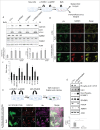SQSTM1/p62-mediated autophagy compensates for loss of proteasome polyubiquitin recruiting capacity
- PMID: 28792301
- PMCID: PMC5640208
- DOI: 10.1080/15548627.2017.1356549
SQSTM1/p62-mediated autophagy compensates for loss of proteasome polyubiquitin recruiting capacity
Abstract
Protein homeostasis in eukaryotic cells is regulated by 2 highly conserved degradative pathways, the ubiquitin-proteasome system (UPS) and macroautophagy/autophagy. Recent studies revealed a coordinated and complementary crosstalk between these systems that becomes critical under proteostatic stress. Under physiological conditions, however, the molecular crosstalk between these 2 pathways is still far from clear. Here we describe a cellular model of proteasomal substrate accumulation due to the combined knockdown of PSMD4/S5a and ADRM1, the 2 proteasomal ubiquitin receptors. This model reveals a compensatory autophagic pathway, mediated by a SQSTM1/p62-dependent clearance of accumulated polyubiquitinated proteins. In addition to mediating the sequestration of ubiquitinated cargos into phagophores, the precursors to autophagosomes, SQSTM1 is also important for polyubiquitinated aggregate formation upon proteasomal inhibition. Finally, we demonstrate that the concomitant stabilization of steady-state levels of ATF4, a rapidly degraded transcription factor, mediates SQSTM1 upregulation. These findings provide new insight into the molecular mechanisms by which selective autophagy is regulated in response to proteasomal overflow.
Keywords: ADRM1/Rpn13; SQSTM1/p62; autophagy; proteasome; ubiquitin receptor PSMD4/Rpn10.
Figures





Similar articles
-
A plastic SQSTM1/p62-dependent autophagic reserve maintains proteostasis and determines proteasome inhibitor susceptibility in multiple myeloma cells.Autophagy. 2015;11(7):1161-78. doi: 10.1080/15548627.2015.1052928. Autophagy. 2015. PMID: 26043024 Free PMC article.
-
Serine 403 phosphorylation of p62/SQSTM1 regulates selective autophagic clearance of ubiquitinated proteins.Mol Cell. 2011 Oct 21;44(2):279-89. doi: 10.1016/j.molcel.2011.07.039. Mol Cell. 2011. PMID: 22017874
-
Stress-induced polyubiquitination of proteasomal ubiquitin receptors targets the proteolytic complex for autophagic degradation.Autophagy. 2017 Apr 3;13(4):759-760. doi: 10.1080/15548627.2016.1278327. Epub 2017 Jan 25. Autophagy. 2017. PMID: 28121483 Free PMC article.
-
p62 links the autophagy pathway and the ubiqutin-proteasome system upon ubiquitinated protein degradation.Cell Mol Biol Lett. 2016 Dec 13;21:29. doi: 10.1186/s11658-016-0031-z. eCollection 2016. Cell Mol Biol Lett. 2016. PMID: 28536631 Free PMC article. Review.
-
Fighting disease by selective autophagy of aggregate-prone proteins.FEBS Lett. 2010 Jun 18;584(12):2635-45. doi: 10.1016/j.febslet.2010.04.041. Epub 2010 Apr 20. FEBS Lett. 2010. PMID: 20412801 Review.
Cited by
-
Construction of an Exudative Age-Related Macular Degeneration Diagnostic and Therapeutic Molecular Network Using Multi-Layer Network Analysis, a Fuzzy Logic Model, and Deep Learning Techniques: Are Retinal and Brain Neurodegenerative Disorders Related?Pharmaceuticals (Basel). 2023 Nov 2;16(11):1555. doi: 10.3390/ph16111555. Pharmaceuticals (Basel). 2023. PMID: 38004422 Free PMC article.
-
Mechanistic Insights into Selective Autophagy Subtypes in Alzheimer's Disease.Int J Mol Sci. 2022 Mar 25;23(7):3609. doi: 10.3390/ijms23073609. Int J Mol Sci. 2022. PMID: 35408965 Free PMC article. Review.
-
Lipid droplets modulate proteostasis, SQST-1/SQSTM1 dynamics, and lifespan in C. elegans.iScience. 2023 Sep 16;26(10):107960. doi: 10.1016/j.isci.2023.107960. eCollection 2023 Oct 20. iScience. 2023. PMID: 37810233 Free PMC article.
-
Hypoexcitability precedes denervation in the large fast-contracting motor units in two unrelated mouse models of ALS.Elife. 2018 Mar 27;7:e30955. doi: 10.7554/eLife.30955. Elife. 2018. PMID: 29580378 Free PMC article.
-
Autophagy and neurodegeneration: Unraveling the role of C9ORF72 in the regulation of autophagy and its relationship to ALS-FTD pathology.Front Cell Neurosci. 2023 Mar 16;17:1086895. doi: 10.3389/fncel.2023.1086895. eCollection 2023. Front Cell Neurosci. 2023. PMID: 37006471 Free PMC article. Review.
References
-
- Lamark T, Johansen T. Autophagy: Links with the proteasome. Curr Opin Cell Biol. 2010;22:192-8. https://doi.org/10.1016/j.ceb.2009.11.002. PMID:19962293. - DOI - PubMed
-
- Nedelsky NB, Todd PK, Taylor JP. Autophagy and the ubiquitin-proteasome system: Collaborators in neuroprotection. Biochim Biophys Acta. 2008;1782:691-9. https://doi.org/10.1016/j.bbadis.2008.10.002. PMID:18930136. - DOI - PMC - PubMed
-
- Shaid S, Brandts CH, Serve H, Dikic I. Ubiquitination and selective autophagy. Cell Death Differ. 2013;20:21-30. https://doi.org/10.1038/cdd.2012.72. PMID:22722335. - DOI - PMC - PubMed
-
- Besche HC, Peth A, Goldberg AL. Getting to first base in proteasome assembly. Cell. 2009;138:25-8. https://doi.org/10.1016/j.cell.2009.06.035. PMID:19596233. - DOI - PMC - PubMed
-
- Deveraux Q, Ustrell V, Pickart C, Rechsteiner M. A 26 S protease subunit that binds ubiquitin conjugates. J Biol Chem. 1994;269:7059-61. https://doi.org/10.1128/MCB.16.11.6020. PMID:8125911. - DOI - PubMed
MeSH terms
Substances
LinkOut - more resources
Full Text Sources
Other Literature Sources
